A Wearable Stiffness-Rendering Haptic Device with a Honeycomb Jamming Mechanism for Bilateral Teleoperation
Abstract
:1. Introduction
2. Materials and Methods
- The honeycomb jamming mechanism is employed in the haptic device, resulting in a wearable, lightweight (20 g), and compact design that ensure finger mobility. This mechanism allows the device to increase its stiffness up to 2.3 times with a 30 kPa vacuum pressure, offering varying levels of finger kinesthetic feedback in teleoperation.
- The proposed stiffness-rendering haptic device is integrated into a bilateral teleoperation framework. This device provides real-time kinesthetic feedback during teleoperated object-grasping tasks, allowing operators to feel remote objects’ stiffness and gauge their grip force.
2.1. Honeycomb Jamming Mechanism
2.2. HJ-Haptic Design
2.3. Stiffness-Rendering Teleoperation Framework
3. Results
3.1. Device Characterization
3.1.1. System Hardware
3.1.2. Effects of Pressure
3.1.3. Stiffness Characterization
3.1.4. Deflection Measurement with Strain Gauge
3.2. Experiment with the Teleoperated Grasping Task
3.2.1. Teleoperation Evaluation
3.2.2. Object Stiffness Evaluation
4. Discussion
5. Conclusions
Author Contributions
Funding
Institutional Review Board Statement
Informed Consent Statement
Data Availability Statement
Acknowledgments
Conflicts of Interest
References
- Li, S.; Rameshwar, R.; Votta, A.M.; Onal, C.D. Intuitive Control of a Robotic Arm and Hand System with Pneumatic Haptic Feedback. IEEE Robot. Autom. Lett. 2019, 4, 4424–4430. [Google Scholar] [CrossRef]
- Liu, Y.; Tsai, Y.Y.; Huang, B.; Guo, J. Virtual Reality Based Tactile Sensing Enhancements for Bilateral Teleoperation System with In-Hand Manipulation. IEEE Robot. Autom. Lett. 2022, 7, 6998–7005. [Google Scholar] [CrossRef]
- Park, S.; Jang, N.; Ihn, Y.S.; Yang, S.; Jeong, J.; Yim, S.; Oh, S.-R.; Kim, K.; Hwang, D. A Tele-Operated Microsurgical Forceps-Driver with a Variable Stiffness Haptic Feedback Master Device. IEEE Robot. Autom. Lett. 2020, 5, 1946–1953. [Google Scholar] [CrossRef]
- Hung KN, G.; Fong, K.N. Effects of Telerehabilitation in Occupational Therapy Practice: A Systematic Review. Hong Kong J. Occup. Ther. 2019, 32, 3–21. [Google Scholar] [CrossRef] [PubMed]
- Kim, S.; Hernandez, I.; Nussbaum, M.A.; Lim, S. Teleoperator-Robot-Human Interaction in Manufacturing: Perspectives from Industry, Robot Manufacturers, and Researchers. IISE Trans. Occup. Ergon. Hum. Factors 2024, 12, 28–40. [Google Scholar] [CrossRef]
- Kazanzides, P.; Vagvolgyi, B.P.; Pryor, W.; Deguet, A.; Leonard, S.; Whitcomb, L.L. Teleoperation and Visualization Interfaces for Remote Intervention in Space. Front. Robot. AI 2021, 8, 747917. [Google Scholar] [CrossRef] [PubMed]
- Muscolo, G.G.; Marcheschi, S.; Fontana, M.; Bergamasco, M. Dynamics Modeling of Human–Machine Control Interface for Underwater Teleoperation. Robotica 2021, 39, 618–632. [Google Scholar] [CrossRef]
- Mete, M.; Jeong, H.; Wang, W.D.; Paik, J. SORI: A Softness-Rendering Interface to Unravel the Nature of Softness Perception. Proc. Natl. Acad. Sci. USA 2024, 121, e2314901121. [Google Scholar] [CrossRef]
- Yin, J.; Hinchet, R.; Shea, H.; Majidi, C. Wearable Soft Technologies for Haptic Sensing and Feedback. Adv. Funct. Mater. 2021, 31, 2007428. [Google Scholar] [CrossRef]
- Pacchierotti, C.; Prattichizzo, D. Cutaneous/Tactile Haptic Feedback in Robotic Teleoperation: Motivation, Survey, and Perspectives. IEEE Trans. Robot. 2024, 40, 978–998. [Google Scholar] [CrossRef]
- Pacchierotti, C.; Meli, L.; Chinello, F.; Malvezzi, M.; Prattichizzo, D. Cutaneous Haptic Feedback to Ensure the Stability of Robotic Teleoperation Systems. Int. J. Robot. Res. 2015, 34, 1773–1787. [Google Scholar] [CrossRef]
- Pacchierotti, C. Cutaneous and Kinesthetic Cues to Improve Transparency in Teleoperation. In Cutaneous Haptic Feedback in Robotic Teleoperation; Springer: Cham, Switzerland, 2016; pp. 93–120. [Google Scholar] [CrossRef]
- Palagi, M.; Santamato, G.; Chiaradia, D.; Gabardi, M.; Marcheschi, S.; Solazzi, M.; Frisoli, A.; Leonardis, D. A Mechanical Hand-Tracking System with Tactile Feedback Designed for Telemanipulation. IEEE Trans. Haptics 2023, 16, 594–601. [Google Scholar] [CrossRef]
- Noguera Cundar, A.; Fotouhi, R.; Ochitwa, Z.; Obaid, H. Quantifying the Effects of Network Latency for a Teleoperated Robot. Sensors 2023, 23, 8438. [Google Scholar] [CrossRef]
- Nomberg, R.; Nisky, I. Human-in-the-Loop Stability Analysis of Haptic Rendering with Time Delay–The Effect of Delayed Feedback Control in the Operator Model. IEEE Robot. Autom. Lett. 2023, 8, 6379–6386. [Google Scholar] [CrossRef]
- Peng, Y.; Sakai, Y.; Nakagawa, K.; Funabora, Y.; Aoyama, T.; Yokoe, K.; Doki, S. Funabot-Suit: A Bio-Inspired and McKibben Muscle-Actuated Suit for Natural Kinesthetic Perception. Biomim. Intell. Robot. 2023, 3, 100127. [Google Scholar] [CrossRef]
- Fu, W.; van Paassen, M.M.; Abbink, D.A.; Mulder, M. Framework for Human Haptic Perception with Delayed Force Feedback. IEEE Trans. Hum.-Mach. Syst. 2019, 49, 171–182. [Google Scholar] [CrossRef]
- Righettini, P.; Strada, R.; Cortinovis, F. Development of an Open Experimental Apparatus for the Comparison of Haptic Teleoperation Control Systems. In Proceedings of the 2024 International Congress on Human-Computer Interaction, Optimization and Robotic Applications (HORA), Istanbul, Turkey, 23–25 May 2024; pp. 1–6. [Google Scholar] [CrossRef]
- Milstein, A.; Alyagon, L.; Nisky, I. Grip Force Control During Virtual Interaction with Deformable and Rigid Objects via a Haptic Gripper. IEEE Trans. Haptics 2021, 14, 564–576. [Google Scholar] [CrossRef] [PubMed]
- Girbés-Juan, V.; Schettino, V.; Demiris, Y.; Tornero, J. Haptic and Visual Feedback Assistance for Dual-Arm Robot Teleoperation in Surface Conditioning Tasks. IEEE Trans. Haptics 2021, 14, 44–56. [Google Scholar] [CrossRef] [PubMed]
- Feng, K.; Xu, Q.; Wong, S.F.; Zi, B. Design and Development of a Teleoperated Telepresence Robot System With High-Fidelity Haptic Feedback Assistance. IEEE Trans. Autom. Sci. Eng. 2024, 1–12. [Google Scholar] [CrossRef]
- Ge, R.; Liu, Y.; Yan, Z.; Cheng, Q.; Qiu, S.; Ming, D. Design of a Self-Aligning Four-Finger Exoskeleton for Finger Abduction/Adduction and Flexion/Extension Motion. In Proceedings of the 2023 International Conference on Rehabilitation Robotics (ICORR), Singapore, 24–28 September 2023; IEEE: Singapore, 2023; pp. 1–6. [Google Scholar] [CrossRef]
- Amirpour, E.; Fesharakifard, R.; Ghafarirad, H.; Rezaei, S.M.; Saboukhi, A.; Savabi, M.; Gorji, M.R. A Novel Hand Exoskeleton to Enhance Fingers Motion for Tele-Operation of a Robot Gripper with Force Feedback. Mechatronics 2022, 81, 102695. [Google Scholar] [CrossRef]
- Giri, A.; Bloom, R.; Morimoto, T.K. Hapstick: A Soft Flexible Joystick for Stiffness Rendering via Fiber Jamming. IEEE Robot. Autom. Lett. 2023, 8, 4163–4170. [Google Scholar] [CrossRef]
- Li, D.; Wang, Z.; Zhou, J.; Liu, Y. Honeycomb Jamming: An Enabling Technology of Variable Stiffness Reconfiguration. Soft Robot. 2021, 8, 720–734. [Google Scholar] [CrossRef]
- Follmer, S.; Leithinger, D.; Olwal, A.; Cheng, N.; Ishii, H. Jamming User Interfaces: Programmable Particle Stiffness and Sensing for Malleable and Shape-Changing Devices. In Proceedings of the 25th Annual ACM Symposium on User Interface Software and Technology, Cambridge, MA, USA, 7–10 October 2012; ACM: Cambridge, MA, USA, 2012; pp. 519–528. [Google Scholar] [CrossRef]
- Stanley, A.A.; Okamura, A.M. Controllable Surface Haptics via Particle Jamming and Pneumatics. IEEE Trans. Haptics 2015, 8, 20–30. [Google Scholar] [CrossRef]
- Simon, T.M.; Smith, R.T.; Thomas, B.H. Wearable Jamming Mitten for Virtual Environment Haptics. In Proceedings of the 2014 ACM International Symposium on Wearable Computers, Cambridge, MA, USA, 7–10 October 2012; ISWC ’14. Association for Computing Machinery: Seattle, WA, USA, 2014; pp. 67–70. [Google Scholar] [CrossRef]
- Zhang, Y.; Wang, D.; Wang, Z.; Zhang, Y.; Xiao, J. Passive Force-Feedback Gloves with Joint-Based Variable Impedance Using Layer Jamming. IEEE Trans. Haptics 2019, 12, 269–280. [Google Scholar] [CrossRef]
- Jadhav, S.; Majit, M.R.A.; Shih, B.; Schulze, J.P.; Tolley, M.T. Variable Stiffness Devices Using Fiber Jamming for Application in Soft Robotics and Wearable Haptics. Soft Robot. 2022, 9, 173–186. [Google Scholar] [CrossRef] [PubMed]
- Yang, B.; Baines, R.; Shah, D.; Patiballa, S.; Thomas, E.; Venkadesan, M.; Kramer-Bottiglio, R. Reprogrammable Soft Actuation and Shape-Shifting via Tensile Jamming. Sci. Adv. 2021, 7, eabh2073. [Google Scholar] [CrossRef] [PubMed]
- Li, S.; Lotfi, A.; Shan, Y.; Wang, K.W.; Rahn, C.D.; Bakis, C.E. A Variable Transverse Stiffness Sandwich Structure Using Fluidic Flexible Matrix Composites (F2MC). In Active and Passive Smart Structures and Integrated Systems 2008; SPIE: Bellingham, WA, USA, 2008; Volume 6928, pp. 155–166. [Google Scholar] [CrossRef]
- Chung, Y.C.; Chow, W.T.; Nguyen, V.P. Soft Robotic Honeycomb-Velcro Jamming Gripper Design. Actuators 2024, 13, 359. [Google Scholar] [CrossRef]
- Frediani, G.; Carpi, F. Tactile Display of Softness on Fingertip. Sci. Rep. 2020, 10, 20491. [Google Scholar] [CrossRef]
- Bianchi, M.; Serio, A. Design and Characterization of a Fabric-Based Softness Display. IEEE Trans. Haptics 2015, 8, 152–163. [Google Scholar] [CrossRef]
- Yoshida, K.; Suzuki, H.; Abe, H.; Ono, A.; Kawaguchi, H.; Sato, M.; Komoriya, Y.; Ohkuri, K. Pneumatic Concave Deformable Device and Finger Deformation-Based Evaluation for Hardness Perception. In Proceedings of the 2021 IEEE World Haptics Conference (WHC), Montreal, QC, Canada, 6–9 July 2021; IEEE: Piscataway, NJ, USA, 2021; pp. 668–673. [Google Scholar] [CrossRef]
- Budd, C.J.; Edmunds, R.; Hunt, G.W. A Nonlinear Model for Parallel Folding with Friction. Proc. R. Soc. London. Ser. A Math. Phys. Eng. Sci. 2003, 459, 2097–2119. [Google Scholar] [CrossRef]
- Lee, Y.; Lee, S.; Lee, D. Wearable Haptic Device for Stiffness Rendering of Virtual Objects in Augmented Reality. Appl. Sci. 2021, 11, 6932. [Google Scholar] [CrossRef]
- Kwok, T.M.; Yu, H. Asymmetric Bimanual ADL Training with Underactuated Exoskeleton Using Independent Joint Control and Visual Guidance. IEEE Access 2024, 12, 9277–9291. [Google Scholar] [CrossRef]
- Sim, D.; Baek, Y.; Cho, M.; Park, S.; Sagar, A.S.M.S.; Kim, H.S. Low-Latency Haptic Open Glove for Immersive Virtual Reality Interaction. Sensors 2021, 21, 3682. [Google Scholar] [CrossRef] [PubMed]
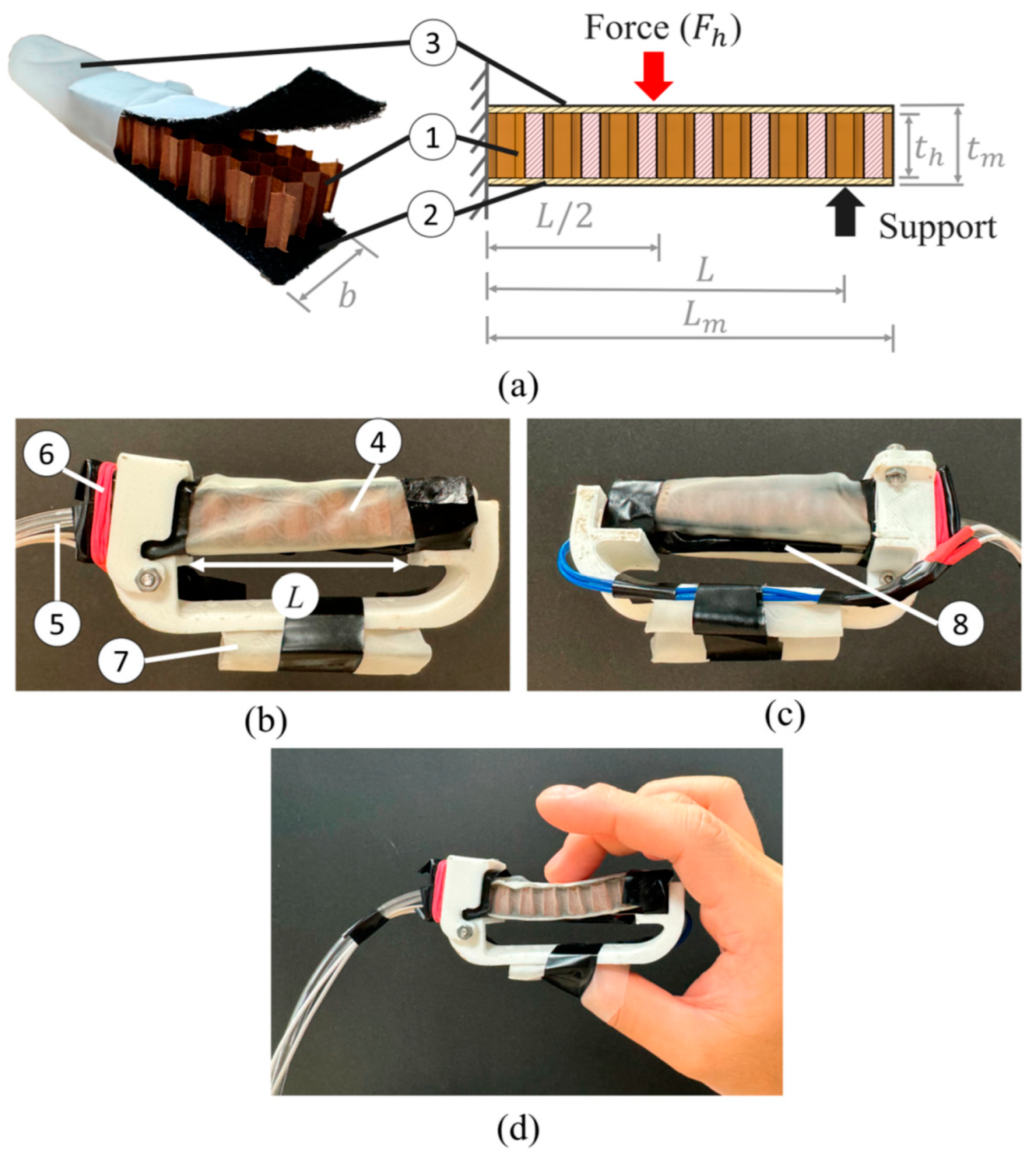

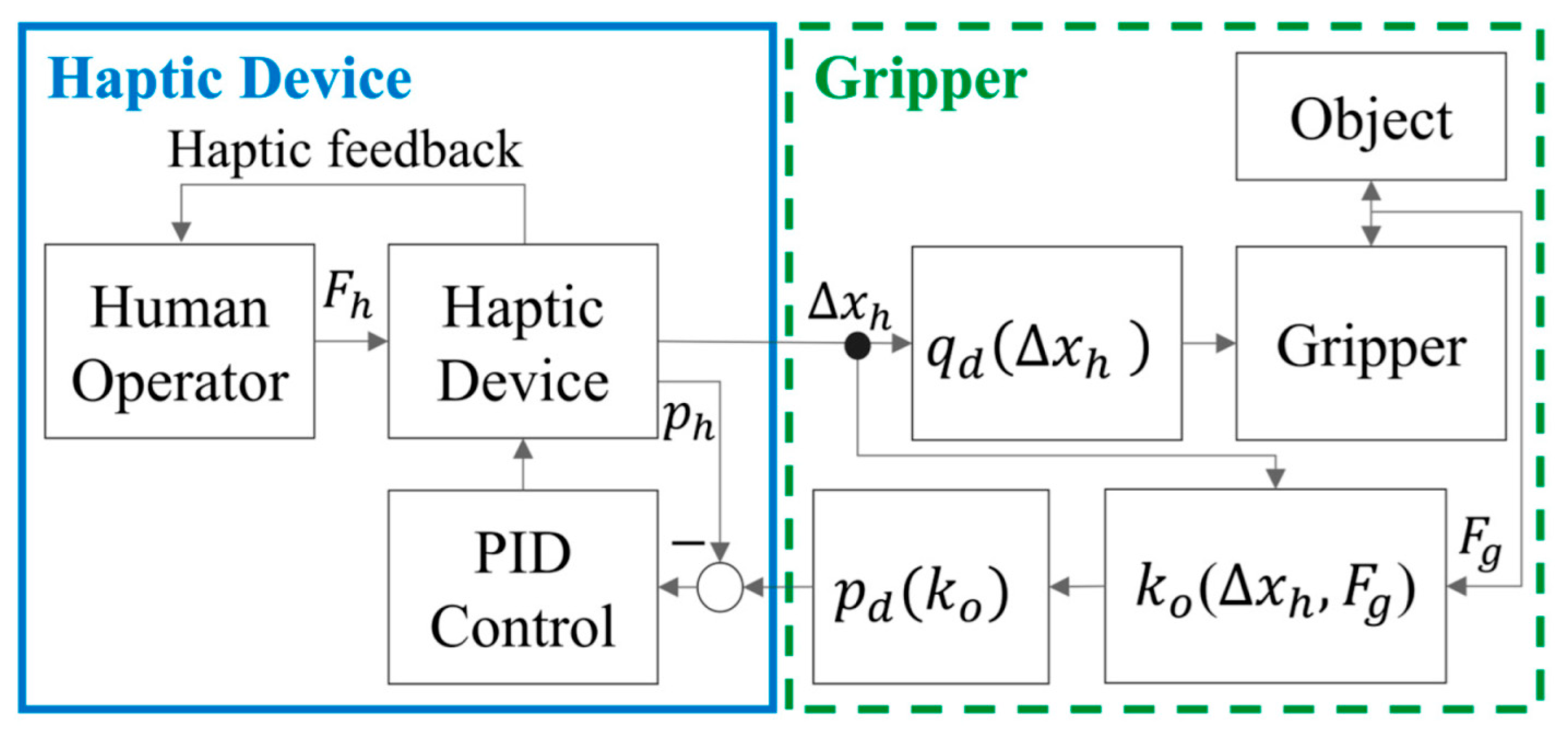
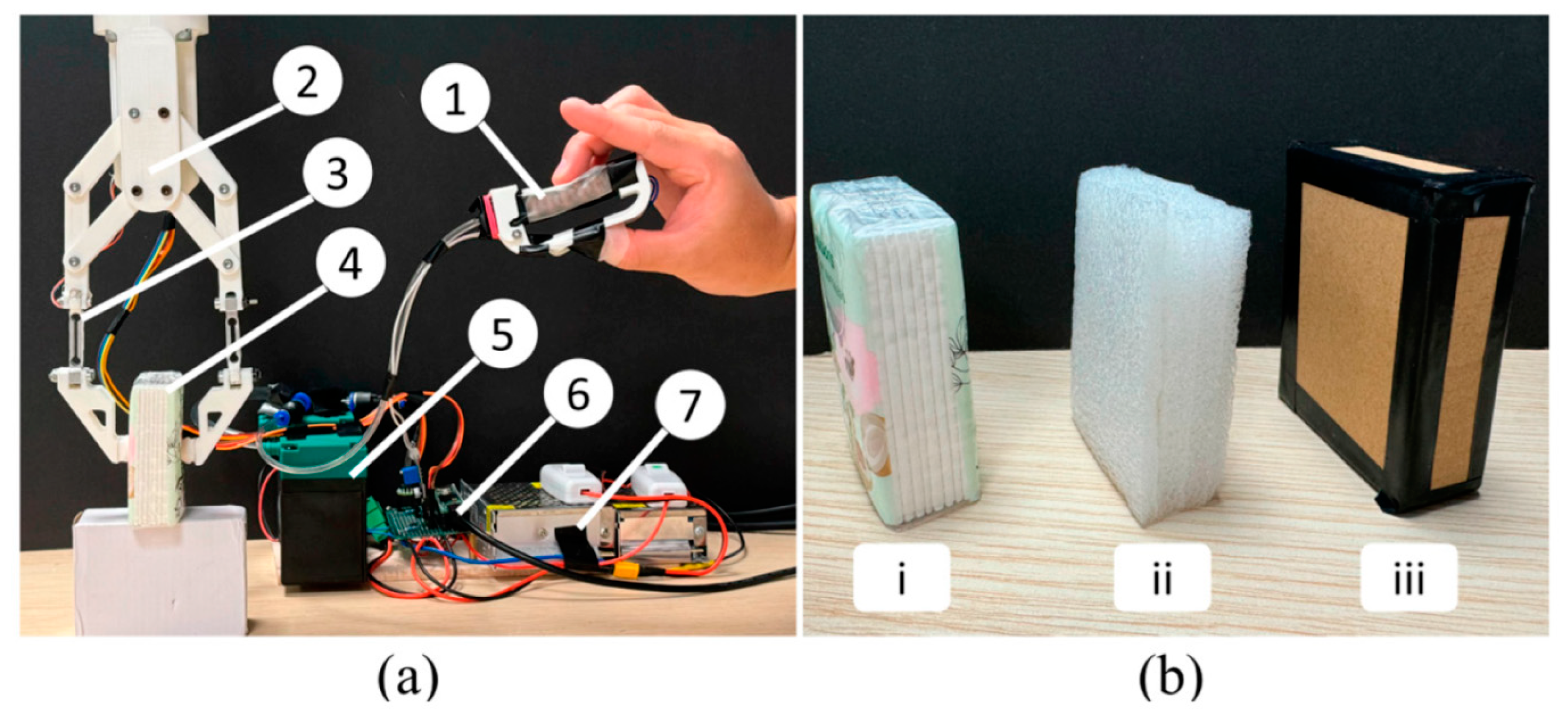
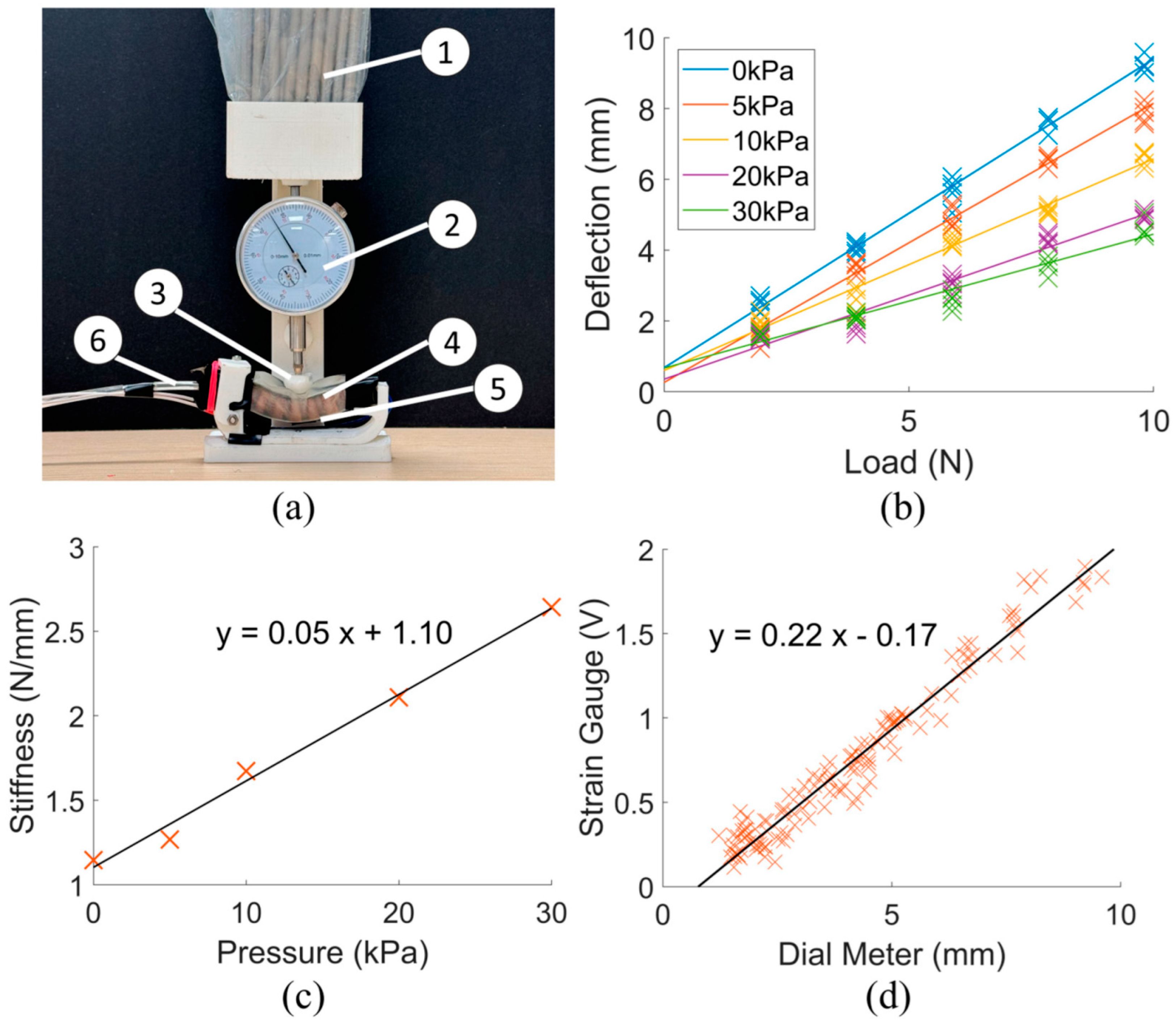

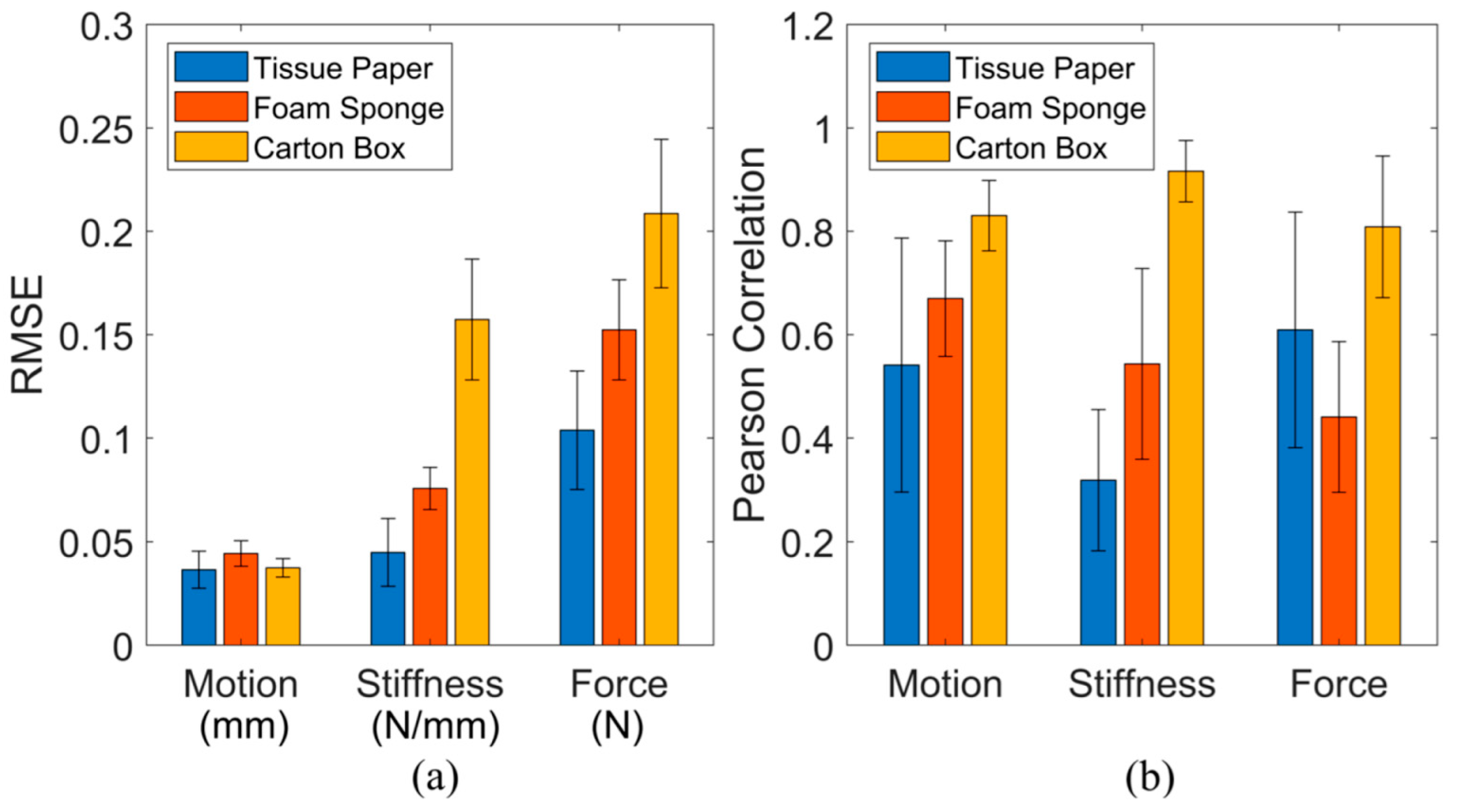


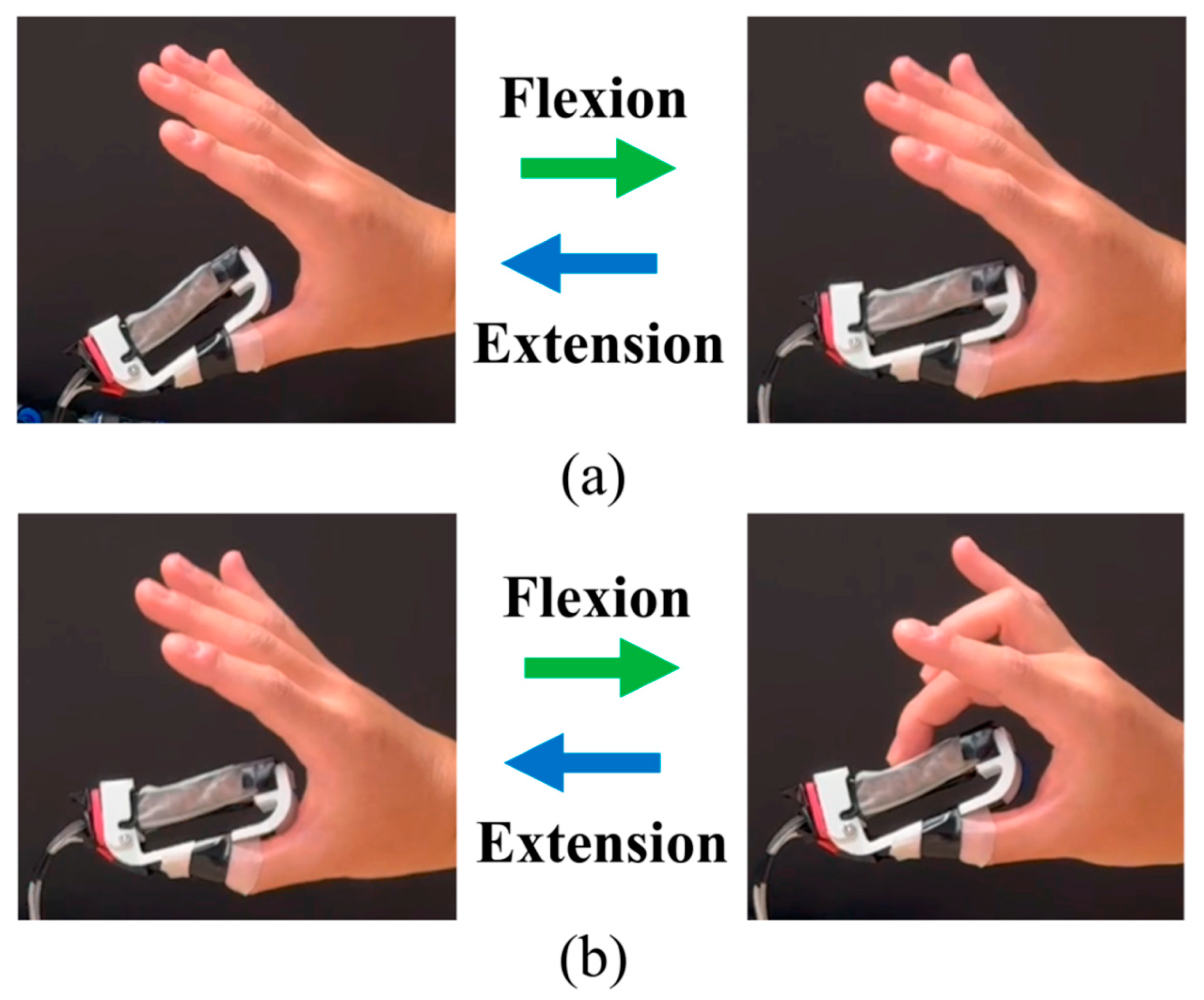
| Parameters | |||||
|---|---|---|---|---|---|
| Value (mm) | 53.5 | 63.5 | 10.0 | 13.0 | 17.0 |
| Vacuum Pressure (kPa) | 0 | 5 | 10 | 20 | 30 |
|---|---|---|---|---|---|
| Stiffness (N/mm) | 1.15 | 1.27 | 1.67 | 2.11 | 2.64 |
| Flexural modulus (MPa) | 0.51 | 0.57 | 0.75 | 0.95 | 1.19 |
| Type 1 (K/C) | Jamming 2 (L/F) | Wearable (Y/N) | Stiffness (N/mm) [Pressure (kPa)] | Ratio per kPa 3 | |
|---|---|---|---|---|---|
| HJ-Haptic | K | L | Y | 1.15–2.64 [0–30] | 0.077 |
| Zhang’s gloves [24] | K | L | Y | 0.15–0.47 4 [0–60] | 0.052 |
| Hapstick [19] | K | F | N | 38.6–192.6 [0–70] | 0.071 |
| SORI [8] | K, C | / | N | 0.16–3.62 5,6 [0–200] | 0.11 6 |
| Tactile displays [28] | C | / | Y | 0.075–0.17 4 [5–20] | 0.15 |
| Motion | Stiffness | Force | |
|---|---|---|---|
| RMSE | 0.04 ± 0.007 mm | 0.09 ± 0.05 N/mm | 0.15 ± 0.05 N |
| 0.68 ± 0.19 | 0.64 ± 0.28 | 0.62 ± 0.22 |
Disclaimer/Publisher’s Note: The statements, opinions and data contained in all publications are solely those of the individual author(s) and contributor(s) and not of MDPI and/or the editor(s). MDPI and/or the editor(s) disclaim responsibility for any injury to people or property resulting from any ideas, methods, instructions or products referred to in the content. |
© 2025 by the authors. Licensee MDPI, Basel, Switzerland. This article is an open access article distributed under the terms and conditions of the Creative Commons Attribution (CC BY) license (https://creativecommons.org/licenses/by/4.0/).
Share and Cite
Kwok, T.M.; Zhang, B.; Chow, W.T. A Wearable Stiffness-Rendering Haptic Device with a Honeycomb Jamming Mechanism for Bilateral Teleoperation. Machines 2025, 13, 27. https://doi.org/10.3390/machines13010027
Kwok TM, Zhang B, Chow WT. A Wearable Stiffness-Rendering Haptic Device with a Honeycomb Jamming Mechanism for Bilateral Teleoperation. Machines. 2025; 13(1):27. https://doi.org/10.3390/machines13010027
Chicago/Turabian StyleKwok, Thomas M., Bohan Zhang, and Wai Tuck Chow. 2025. "A Wearable Stiffness-Rendering Haptic Device with a Honeycomb Jamming Mechanism for Bilateral Teleoperation" Machines 13, no. 1: 27. https://doi.org/10.3390/machines13010027
APA StyleKwok, T. M., Zhang, B., & Chow, W. T. (2025). A Wearable Stiffness-Rendering Haptic Device with a Honeycomb Jamming Mechanism for Bilateral Teleoperation. Machines, 13(1), 27. https://doi.org/10.3390/machines13010027





